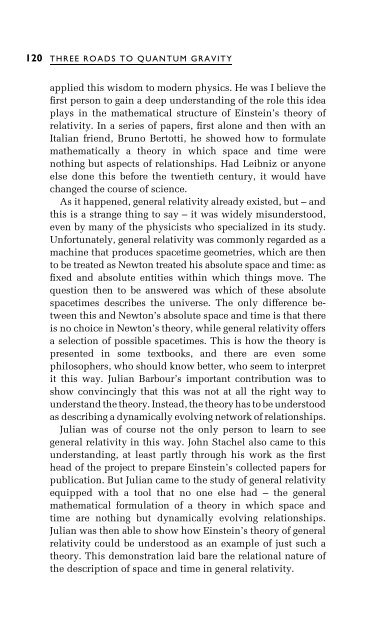Three Roads To Quantum Gravity
Three Roads To Quantum Gravity
Three Roads To Quantum Gravity
You also want an ePaper? Increase the reach of your titles
YUMPU automatically turns print PDFs into web optimized ePapers that Google loves.
120 THREE ROADS TO QUANTUM GRAVITY<br />
applied this wisdom to modern physics. He was I believe the<br />
®rst person to gain a deep understanding of the role this idea<br />
plays in the mathematical structure of Einstein's theory of<br />
relativity. In a series of papers, ®rst alone and then with an<br />
Italian friend, Bruno Bertotti, he showed how to formulate<br />
mathematically a theory in which space and time were<br />
nothing but aspects of relationships. Had Leibniz or anyone<br />
else done this before the twentieth century, it would have<br />
changed the course of science.<br />
As it happened, general relativity already existed, but ± and<br />
this is a strange thing to say ± it was widely misunderstood,<br />
even by many of the physicists who specialized in its study.<br />
Unfortunately, general relativity was commonly regarded as a<br />
machine that produces spacetime geometries, which are then<br />
to be treated as Newton treated his absolute space and time: as<br />
®xed and absolute entities within which things move. The<br />
question then to be answered was which of these absolute<br />
spacetimes describes the universe. The only difference between<br />
this and Newton's absolute space and time is that there<br />
is no choice in Newton's theory, while general relativity offers<br />
a selection of possible spacetimes. This is how the theory is<br />
presented in some textbooks, and there are even some<br />
philosophers, who should know better, who seem to interpret<br />
it this way. Julian Barbour's important contribution was to<br />
show convincingly that this was not at all the right way to<br />
understand the theory. Instead, the theory has to be understood<br />
as describing a dynamically evolving network of relationships.<br />
Julian was of course not the only person to learn to see<br />
general relativity in this way. John Stachel also came to this<br />
understanding, at least partly through his work as the ®rst<br />
head of the project to prepare Einstein's collected papers for<br />
publication. But Julian came to the study of general relativity<br />
equipped with a tool that no one else had ± the general<br />
mathematical formulation of a theory in which space and<br />
time are nothing but dynamically evolving relationships.<br />
Julian was then able to show how Einstein's theory of general<br />
relativity could be understood as an example of just such a<br />
theory. This demonstration laid bare the relational nature of<br />
the description of space and time in general relativity.



![arXiv:1001.0993v1 [hep-ph] 6 Jan 2010](https://img.yumpu.com/51282177/1/190x245/arxiv10010993v1-hep-ph-6-jan-2010.jpg?quality=85)


![arXiv:1008.3907v2 [astro-ph.CO] 1 Nov 2011](https://img.yumpu.com/48909562/1/190x245/arxiv10083907v2-astro-phco-1-nov-2011.jpg?quality=85)








![arXiv:1002.4928v1 [gr-qc] 26 Feb 2010](https://img.yumpu.com/41209516/1/190x245/arxiv10024928v1-gr-qc-26-feb-2010.jpg?quality=85)
![arXiv:1206.2653v1 [astro-ph.CO] 12 Jun 2012](https://img.yumpu.com/39510078/1/190x245/arxiv12062653v1-astro-phco-12-jun-2012.jpg?quality=85)
